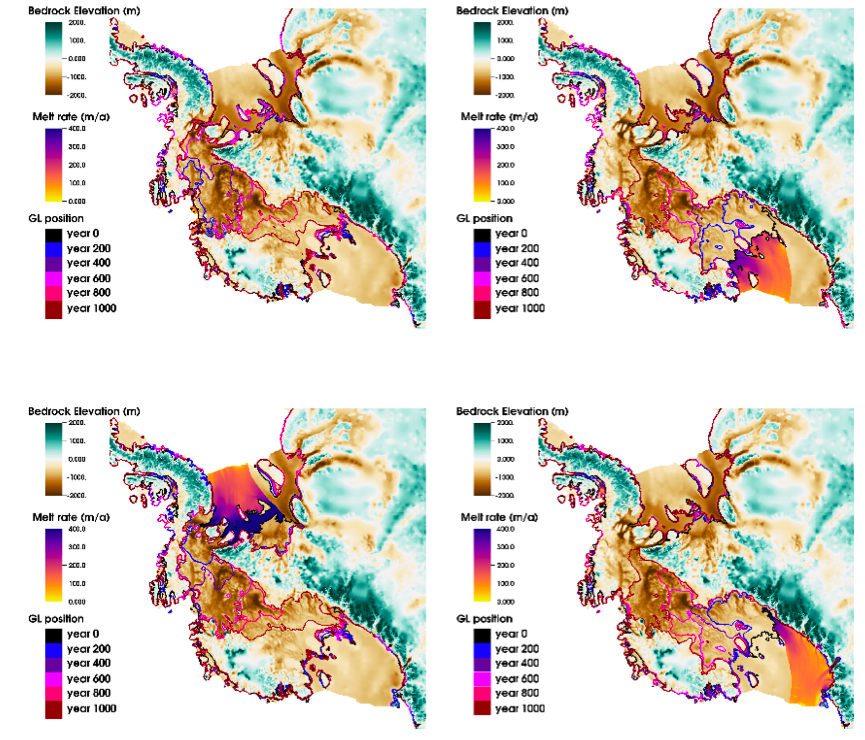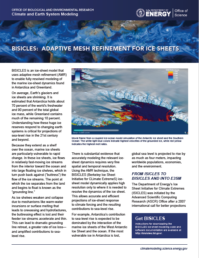Antarctic Ice Shelf Collapse

Antarctic vulnerability to localized ice shelf collapse. Initial modeled flow speed is shown in shaded blue. Magenta lines indicate initial grounding-line locations. Mass lost above flotation (eustatic sea level equivalent, SLE) after 1000 years of extreme, sustained ice shelf thinning originating in the numbered sectors is illustrated by the adjacent circle area.
Millennial-scale Vulnerability of the Antarctic Ice Sheet to Regional Ice Shelf Collapse
Ice sheet model with variable resolution is used to evaluate vulnerable regions of the Antarctic ice sheet.
The Science
The biggest uncertainty in near-future sea level rise (SLR) comes from the Antarctic Ice Sheet. Antarctic ice flows in relatively fast-moving ice streams from the interior to the ocean, where it is carried into enormous floating ice shelves which push back on their feeder ice streams, buttressing them and slowing their flow. Melting and loss of ice shelves due to climate change can result in faster ice flow, ice sheet thinning and retreat, and a resulting accelerated contribution to global sea level rise.
The Impact
An ice sheet model sensitivity study identified the three ice shelves connected to West Antarctica as most prone to destabilization. Sustained ice-shelf loss in any of the Amundsen Sea, Ronne, or Ross sectors is shown to lead to wholesale West Antarctic ungrounding and collapse.

Grounding-line evolution illustrated with contours every 200 years for the Amundsen Sea (upper left), the Eastern Ross (upper right), the Ronne (lower left), and the Western Ross (lower right) sectors. Colormap shows initial melt-forcing distribution for each case.
Summary
To better understand where the Antarctic ice sheet (AIS) is vulnerable to ice-shelf loss, a team of researchers led by Lawrence Berkeley National Laboratory, divided the AIS into 14 regional sectors, which roughly correspond to large-scale Antarctic drainage basins. Using their high-resolution (1 km or finer) BISICLES ice sheet model, they applied extreme thinning rates to each sector’s floating ice shelves in turn, then ran the model 1000 years into the future for each case. They found three levels of vulnerability. The greatest vulnerability came from destabilizing any of the three ice shelves connected to West Antarctica, where much of the ice sits on bedrock below sea level. Each of those dramatic responses contributed around 2 m of sea level rise. The second level of vulnerability came from four other sectors, each with a contribution between 0.5-1 m. The remaining sectors produced little to no contribution. They also examined combinations of sectors, determining that sectors behave independently of each other for at least a century.
Publication
Martin, Cornford, and Payne (2019). Geophysical Research Letters, DOI 10.1029/2018GL081229.
Also visit the Biological and Environmental Research (BER) web page for this publication.
BISICLES
More info on BISICLES can be found in Technical Highlight:
BISICLES: Adaptive Mesh Refinement for Ice Sheets
See also Antarctic Ice Sheet Simulations post
Contact: Dan Martin, Lawrence Berkeley National Laboratory
Funding: Earth and Environmental System Modeling and SciDAC (BER/ASCR).




